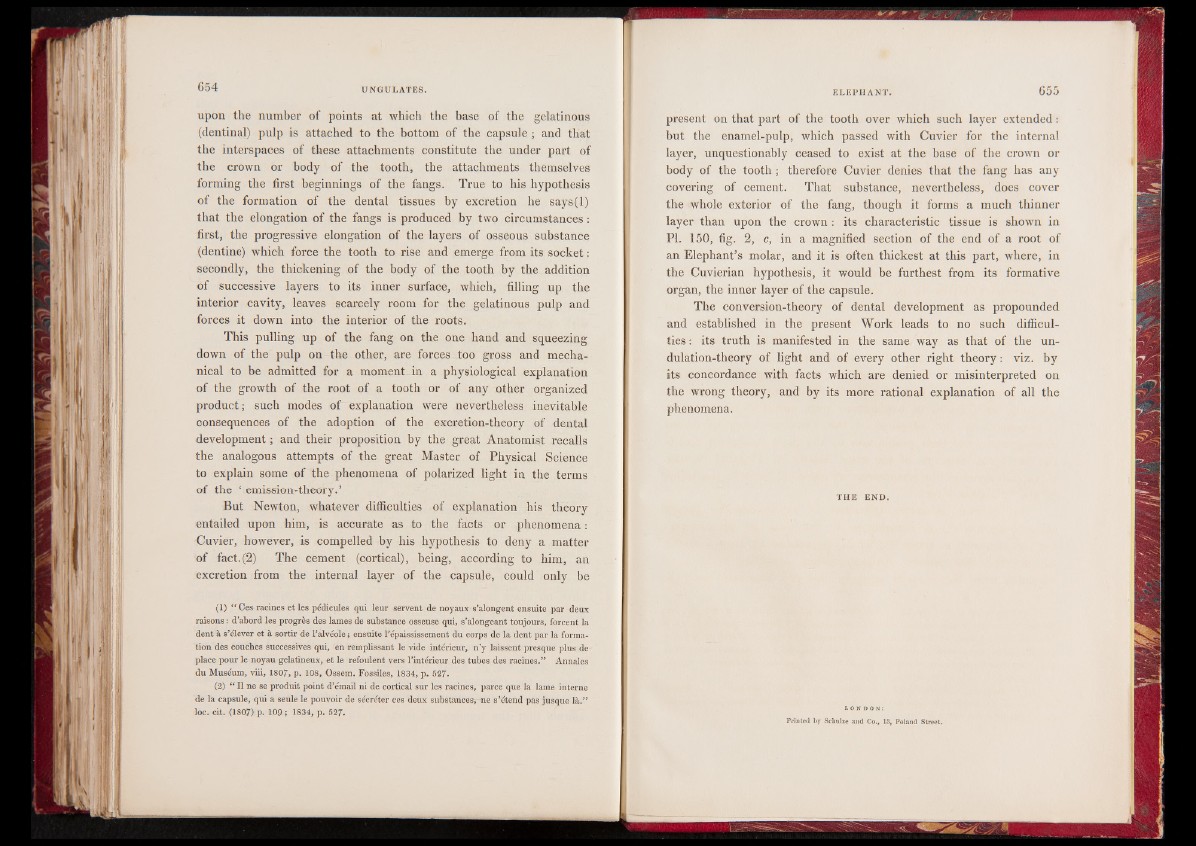
upon the number of points at which the base of the gelatinous
(dentinal) pulp is attached to the bottom of the capsule | and that
the interspaces of these attachments constitute the under part of
the crown or body of the tooth, the attachments themselves
forming the first beginnings of the fangs. True to his hypothesis
of the formation of the dental tissues by excretion he says(l)
that the elongation of the fangs is produced by two circumstances:
first, the progressive elongation of the layers of osseous substance
(dentine) which force the tooth to rise and emerge from its socket;
secondly, the thickening of the body of the tooth by the addition
of successive layers to its inner surface, which, filling up the
interior cavity, leaves scarcely room for the gelatinous pulp and
forces it down into the interior of the roots.
This pulling up of the fang on the one hand and squeezing
down of the pulp on the other, are forces too gross and mechanical
to be admitted for a moment in a physiological explanation
of the growth of the root of a tooth or of any other organized
product; such modes of explanation were nevertheless inevitable
consequences of the adoption of the excretion-theory of dental
development; and their proposition by the great Anatomist recalls
the analogous attempts of the great Master of Physical Science
to explain some of the phenomena of polarized light in the terms
of the ‘ emission-theory.’
But Newton, whatever difficulties of explanation his theory
entailed upon him, is accurate as to the facts or phenomena:
Cuvier, however, is compelled by his hypothesis to deny a matter
of fact.(2) The cement (cortical), being, according to him, an
excretion from the internal layer of the capsule, could only be
(1) “ Ces racines et les pédicules qui leur servent de noyaux s’alongent ensuite par deux
raisons : d’abord les progrès des lames de substance osseuse qui, s’alongeant toujours, forcent la
dent à s’élever et à sortir de l’alvéole ; ensuite l’épaississement du corps de la dent par la formation
des couches successives qui, en remplissant le vide intérieur, n’y laissent presque plus de
place pour le noyau gélatineux, et le refoulent vers l'intérieur des tubes des racines.” Annales
du Muséum, viii, 1807, p. 108, Ossem. Fossiles, 1834, p. 527.
(2) “ Il ne se produit point d’émail ni de cortical sur les racines, parce que la lame interne
de la capsule, qui a seule le pouvoir de sécréter ces deux substances, ne s’étend pas jusque là.”
loc. cit. (1807) p. 109 ; 1834, p. 527.
present on that part of the tooth over which such layer extended:
but the enamel-pulp, which passed with Cuvier for the internal
layer, unquestionably ceased to exist at the base of the crown or
body of the tooth ; therefore Cuvier denies that the fang has any
covering of cement. That substance, nevertheless, does cover
the whole exterior of the fang, though it forms a much thinner
layer than upon the crown : its characteristic tissue is shown in
PI. 150, fig. 2, c, in a magnified section of the end of a root of
an Elephant’s molar, and it is often thickest at this part, where, in
the Cuvierian hypothesis, it would be furthest from its formative
organ, the inner layer of the capsule.
The conversion-theory of dental development as propounded
and established in the present Work leads to no such difficulties:
its truth is manifested in the same way as that of the undulation
theory of light and of every other right theory: viz. by
its concordance with facts which are denied or misinterpreted on
the wrong theory, and by its more rational explanation of all the
phenomena.
THE END.
L O N D O N :